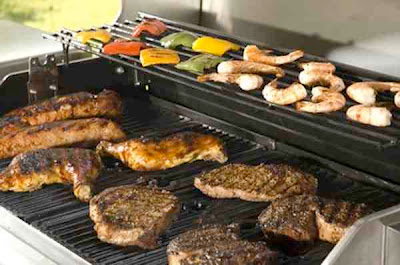Food is responsible for ten to thirty percent of global greenhouse gas emissions. By many estimates, cooking represents more of a meal’s carbon footprint than its transport. For certain vegetables, it accounts for more emissions than agriculture, transport and disposal combined.
I’m not advising you to forsake grilling this holiday and join the ranks of raw-foodists. Nor do I believe that we can reverse climate change by eating burgers rare instead of well done. But a little creative thinking can reduce this year’s Fourth of July carbon emissions without gustatory sacrifice. And maybe that awareness will carry into other days and other parts of our lives.
Consider potato salad: a pale mixture of boiled potatoes and mayonnaise that is sometimes appetizing but always wasteful. An overwhelming majority of the energy in boiling goes into heating the water rather than cooking the potatoes. Direct-heat methods are more efficient and usually tastier. Cubed and pan-fried potatoes take just ten minutes to cook and require less than one-third the energy of boiling. (According to my math, microwaving potatoes is about forty percent more efficient than pan-frying them on an electric stove, but when I do it the potatoes come out rubbery, and that is too much sacrifice for a holiday.) If you insist on boiling, lower the heat once bubbles appear. Keeping the burner on high only speeds evaporation; it doesn’t make the water any hotter or shorten cooking time. And cut the pieces small, because cooking time decreases as surface area increases.
Now for the burgers and dogs. First, a green disclaimer. Beef is an environmental disaster, no matter how you cook it. However, if you can’t resist grilled cow, your big decision is between charcoal and propane.
Charcoal is made of wood, so the carbon it releases upon combustion is approximately equal to the carbon the tree it came from once removed from the atmosphere. In theory, charcoal should be less damaging than propane, which releases carbon that has been sequestered harmlessly underground for hundreds of millions of years. It’s far more complicated in practice, though. We get most lump charcoal from cutting down mesquite trees, and in addition to the deforestation effect, it takes more fuel to produce and transport charcoal than it does propane. As a result, according to a 2009 study in the journal Environmental Impact Assessment Review, propane is nearly three times as efficient as lump charcoal.
Charcoal briquettes, however, are a different story. The compressed round briquettes are made from scrap wood that would otherwise go to waste. The better manufacturers build their plants near construction centers and use recycled heat from those centers to power their briquette kilns. If you take that into account, charcoal briquettes are ahead of lump charcoal and propane as the best option in terms of climate change. (Any kind of charcoal, however, releases more particulate matter than propane, which makes charcoal a greater contributor to air pollution. There are few easy choices in environmental analysis.)
And finally we come to dessert. Skip the pie. Baking is so energy profligate that the government hasn’t yet figured out a way to reward any residential ovens with the Energy Star label.
Here’s where you can really make use of your briquettes. One problem with charcoal is that you can’t turn it off when the burgers are done. In most backyards that means lots of heat— and carbon dioxide— goes to waste. Not in your yard, though. Use that leftover charcoal glow to grill up dessert. Apples, pears, peaches, and nectarines grill beautifully, and are even better à la mode. Or you can prepare a cobbler in a foil pan and grill it on the dying coals. From an environmental perspective, that’s free energy.
Maybe an Independence Day meal of pan-fried potatoes and grilled peaches seems un-American. But the tradition of backyard grilling isn’t exactly Jeffersonian in pedigree. Independence Day feasts in the early 1800s featured such classic American fare as turtle soup. By midcentury, revelers were gathering en masse to buy parts of whole roast pigs from street vendors. (A British visitor pondered: “What association can there be between roast pig and independence?”) Backyard grilling didn’t become popular until the interwar period at the earliest, and accelerated with the baby boom and suburbanization that followed World War Two. In other words, there’s nothing so very sacred about the Fourth of July cookout. So this year, why not experiment?
30 June 2011
On a lighter note, the Fourth of July is coming
Rico says Brian Palmer has an article in The New York Times about the ecological way to grill on the Fourth:
Subscribe to:
Post Comments (Atom)








No comments:
Post a Comment